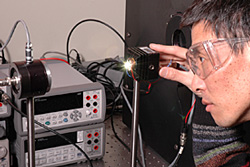
| Home | About Us | Contribute | Bookstore | Advertising | Subscribe for Free NOW! |
| News Archive | Features | Events | Recruitment | Directory |
| FREE subscription |
| Subscribe for free to receive each issue of Semiconductor Today magazine and weekly news brief. |
News
27 November 2008
NIST devises LED test method comparable to lighting tests
At the 2008 Expert Symposium on Advances in Photometry and Colorimetry, researchers at the National Institute of Standards and Technology (NIST) in Gaithersburg, MD, USA presented a new, economical method to allow LED and lighting manufacturers to obtain accurate, reproducible, and comparable measurements of LED brightness and color (Y. Zong and Y. Ohno, Proc. CIE Expert Symposium on Advances in Photometry and Colorimetry. CIE x033:2008, 102-106). Up to now, the lack of common measurement methods among LED and lighting manufacturers has delayed the commercialization of solid-state lighting products.
The quality of light that high-power LEDs produce depends on their operating temperature. To speed production, LED makers typically use high-speed optical pulses to measure the color and brightness of their products. However, because pulsed measurements do not give the LED chip time to warm to its normal operating temperature, the measured light output quality is not the same as would be realized in actual lighting products.
The lighting industry uses a steady-state DC measurement approach (similar to that used for traditional incandescent and fluorescent lamps) involving turning the light on, letting it warm up, and measuring the characteristics of the light produced. Although time-consuming, DC measurement provides a more realistic test of how the lighting product will perform. The problem was that researchers did not understand how the DC measurement results correlated with the pulse measurement results that LED manufacturers use.
 NIST’s Yuqin Zong and Yoshi Ohno have created a standard high-power LED measurement method that satisfies the needs of both LED and lighting makers. The method uses the fact that the optical and electrical characteristics of an LED are interrelated and a function of the LED’s junction temperature (the temperature of the chip inside the LED, which is normally very difficult to measure).
NIST’s Yuqin Zong and Yoshi Ohno have created a standard high-power LED measurement method that satisfies the needs of both LED and lighting makers. The method uses the fact that the optical and electrical characteristics of an LED are interrelated and a function of the LED’s junction temperature (the temperature of the chip inside the LED, which is normally very difficult to measure).
Picture: NIST’s Yuqin Zong.
The new method entails mounting the LED on a temperature-controlled heat sink set to the desired LED junction temperature between 10°C and 100°C. After applying a pulse of electricity through the LED and measuring the voltage flowing across the junction, the researchers turn on the DC power to the LED and adjust the temperature of the heat sink to ensure the voltage remains constant. The method allows measurement of the LED’s light output at a junction temperature similar to that found in a commercial lighting fixture (important to lighting manufacturers) at but high speed (important to LED manufacturers). The measurement results can be reproducible regardless of pulse or DC operation, or type of heat sink, say the researchers.
The new method also allows the measurement of heat flow in and out of the LED, enabling LED and lighting manufacturers to improve the LED's design and the thermal management system of the associated lighting product. Effective thermal management is important in lighting products, because LEDs perform more efficiently and last much longer at lower temperatures.
![]() Search: LEDs
Search: LEDs
Visit: www.nist.gov